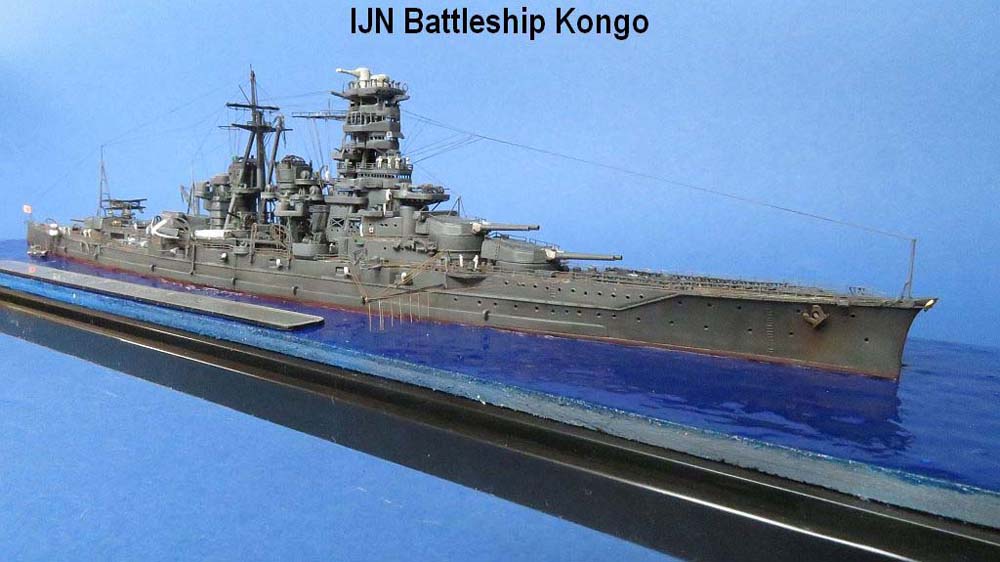
1/700 IJN Kongo (Fujimi)
|
by Christian Hoeltge |

1/700 IJN Kongo (Fujimi)
The Kongo was the lead ship of the four Kongo battlecruisers. At the same time she was the first battle cruiser of the Japanese Navy and also the last ship built outside of Japan. The sister ships were all built in Japan. The Kongo was orderd in 1910 in response to the first battlecruiser, the HMS Invincible. The four battlecruisers were part of the "eight-eight" fleet after eight battlecruisers and battleships were built to renew the Japanese fleet. These included the incomplete Amagi battlecruisers, the Yamashiro and Ise half-sisters, the Nagato and the also no longer completed Tosa battleships.With the commissioning of the Kongo she was the strongest ship of the Japanese fleet. It had for the first time as a main armament four twin turrets with 356 mm (14 in) guns. The secondary armament consisted of sixteen 152 mm guns. In addition there were eight 76 mm guns and four 6.5 mm machine guns.
The Kongo was laid in 1911 in the Vickers shipyard in Barrows-in-Furness and the launching was on 18 May 1912. The completion took place in Portsmouth. On 16 August 1913, the Kongo was completed and went into service. After a few missions in the First World War, the Kongo was continuously rebuilt and improved after the war. After Japan wasn't allowed to build no new capital ships by the Washington naval agreement , the Kongo was rebuilt with her sister ships to a fast battleship. The hull was extended by 8 m and the armor was strengthened. The machinery was also replaced to allow the Kongo to compete with the aircraft carriers. The superstructures were also enlarged to accommodate different target devices. As with the other battleships of the Japanese Navy, this led to the characteristic pagoda layout of the bridge. The armament was now apart from the unchanged main armament only fourteen 152 mm guns. As an anti-aircraft weapon, the Kongo had four 12.7 cm twin guns and twelve 25 mm twin guns. The first use as a fast battleship had the Kongo 1938 in the war against China. With the beginning of the Pacific War, the Kongo was used to escort the landing in the Philippines. In 1942, the Kongo together with the Haruna bombarded the Henderson airfield on Guadalcanal. The Kongo, along with its sister ships, took part in several battles at Guadacanal. In 1943, the Kongo was rebuilt again and received a reinforced anti-aircraft weapons and radars. The Kongo ran out in 1944 for the Battle of Leyte. There she scored hits on the light aircraft carrier Gambier Bay and sank the destroyer Samuel B. Roberts. On 21 November, the Kongo along with the Nagato and the Yamato was discovered while driving through the Formosa road from the US submarine Sealion. The submarine shot six torpedoes, of which two hit the Kongo. Another torpedo hit and sunk the destroyer Urakaze. The Kongo was able to continue at a slower speed, but the ingress of water could not be stopped. Due to heavy list ammunition exploded in one of the magazines and the Kongo sank. Only 237 survivors could be rescued.
The kit comes from the company Fujimi. In the program, Fujimi has the Kongo in the version from 1941 and from 1944. I started the kit in 2015 as my first kit of a Japanese ship. It was then built very quickly but then disappeared on the shelf of shame. With a bit more motivation to finish more kits than to start, I finished it by the end of 2017. I chose the version of 1941 because I find battleships with less anti-aircraft weapons more interesting. In addition to the kit, I used a complete etching set from Tetra Model Works. This contains all the necessary etched parts to enhance the model. However, as with the set to Ryujo missing the parts for the anti-aircraft weapons and for the small rafts. Regardless, the set was very easy to work with. The separate linoleum decks for the bridge also helped the painting. Additionally, I used flyhawk etching parts for the light flak and small boats. The anchors were replaced by those from Flyhawk. The heavy flak was replaced by those of Ocean Spirit. On the bridge, various targeting devices and binoculars from Shelf Oddity were used. Unfortunately, these are missing in the Fujimi kit. Also, by Shelf Oddity is the crew.
I painted the model with Tamiya's Sasebo Gray. The details as well as the wooden deck I painted with Vallejo colors. For the first time I painted the deck first, then painted some planks and then aged the deck with oil paint. Then I taped the deck and painted the hull gray. A working method that I'm almost always use now. The water design was done as usual with the Water Effects of Vallejo.
